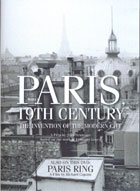
Paris, 19th Century the Invention of the Modern City 1991
Distributed by Icarus Films, 32 Court St., 21st Floor, Brooklyn, NY 11201; 800-876-1710
Produced by Stan Neumann
Directed by Stan Neumann
DVD, b&w;, 49 min.
Sr. High - Adult
Architecture, Art, History, Urban Planning, Regional Planning
Date Entered: 08/18/2010
Reviewed by Winifred Fordham Metz, University of North Carolina at Chapel HillPart history, part homage, part city symphony, this deceptively subtle and poetic film sets out to uncover the forgotten memory of Paris’ architectural face. Stan Neumann deftly follows art historian Francois Loyer as he makes his way carefully and deliberately through Paris. Nooks, crannies, grand boulevards, garrets, stairwells and maze-like rooftops are all traversed by the intrepid historian – each resplendently displayed in black and white footage.
Nineteenth century Paris, also known as Haussmann’s Paris, saw the addition of a series of very wide, grand boulevards set between rows of methodically designed, perfectly aligned facades. Directly behind these facades, live remnants of the Paris of old. Neumann’s camera reveals all as it closely trails Loyer describing the progression of the city from a collection of tightly bound neighborhoods heavily veined with tapered alleyways and slender streets to one seemingly more widespread and spacious. In the shadows of Saint-Michel, the Saint Severin district thrives with its uneven line of storefronts and apartments flanking narrow streets and alleyways. Avenue Simon Bolivar was treated much the same way, with a grand avenue and impressive urban façade superimposed on the front of the old suburban one. Once considered stately, Porte Saint-Martin (17th century arc honoring Louis XIV) was eclipsed by a string of apartment houses built up around it mid-century. With these examples and more, Loyer deftly illustrates how the city’s scale and value changed during the 19th century.
While the primary focus is arguably one of urban design, this film also serves as a skillfully layered treatise on the political and social evolution of the city. Loyer’s precise investigation of the architecture and Neumann’s careful gaze chart class distinctions and social strata built into the structures themselves. Doors, courtyards, windows, cornices, and stairwells take on new meaning. Reconciling these grand public spaces that belong to everyone with the private spaces typically obscured to most but a few, seems to be of interest here. This sense of duality remains a constant theme throughout the documentary—of public and private, ornate and practical. The facades on the grand boulevards are constantly compared to what exists behind them. Aerial views of the city are juxtaposed with sequences shot on the streets. Courtyards and vestibules are compared. Interestingly, the film provides entrée to the interiors and personal lives of the city’s inhabitants without ever engaging anyone directly in the film (objective view versus personal experience). And, Loyer and Neumann execute all of this with cleverly articulated whimsy and humor—with the camera resting lengthily on a courtyard wall adorned with Dr. Jekyll & Mr. Hyde graffiti (ultimate personification of duality), offering a cityscape’s distorted reflection in Loyer’s helmet as he rides his moped through the avenues of Paris, to a band of youth roller-skating down the middle of a deserted grand boulevard.
This clever film is highly recommended for anyone interested in architecture, art, history, city & regional planning, urban design, social and economic issues or simply…Paris. It would find notable use in university classrooms.
Further viewing: Paris Ring (2010) Grand Paris (2010).